Complete Solutions to JEE Main And Advanced of chapter ALDEHYDES AND KETONES of Class 12 book with complete answers and questions
| Class 12 | CHEMISTRY |
| Chapter | ALDEHYDES AND KETONES |
| IIT-JEE PREVIOUS YEAR | JEE Main And Advanced |
| Number Of Questions | 95 |
| Academic Year | 2023-24 |
The correct sequence of reagents for the following conversion will be
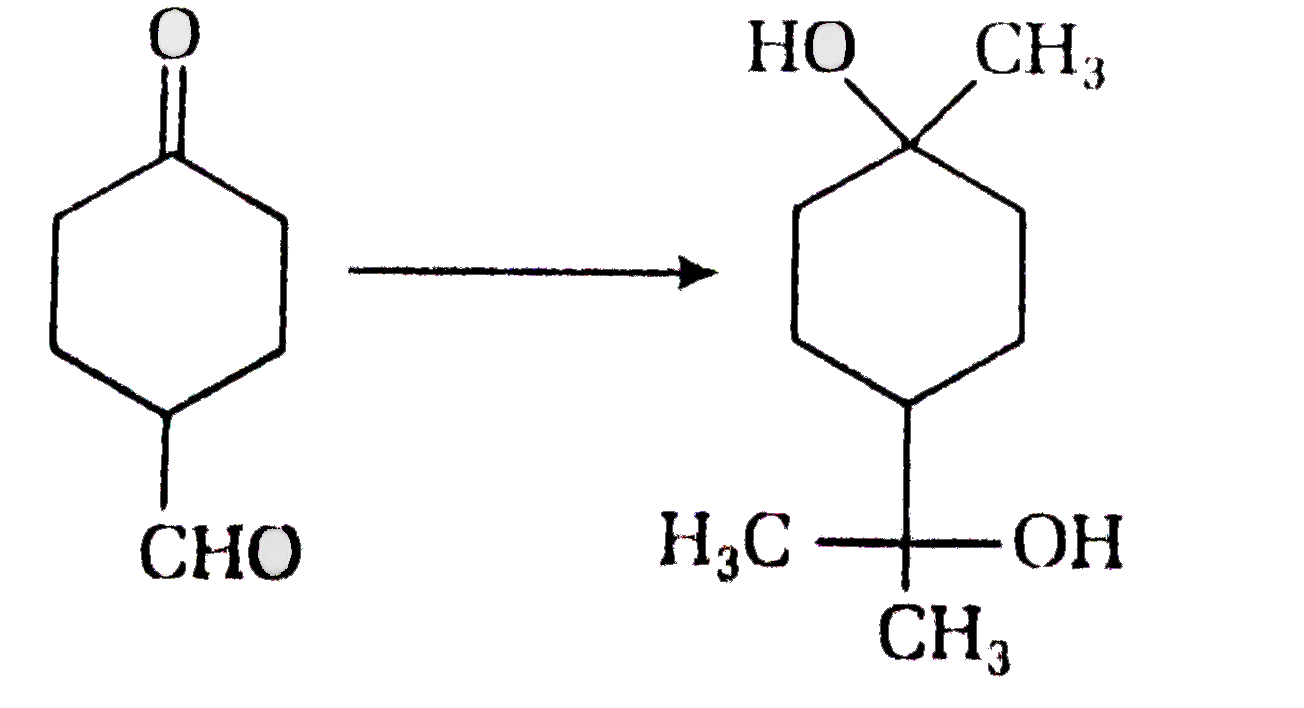 07:09View Solution
07:09View SolutionThe major product of the following reaction sequence is
 06:11View Solution
06:11View SolutionThe compound which would yield `5-` Oxo`-2-`methylhexanal on reductive ozonolysis
04:19View SolutionThe major product in the following reaction is
 02:39View Solution
02:39View SolutionThe most suitable reagent for the conversion of
`R- CH_(2) - OH rarr R-CHO` is01:52View SolutionThe major product `H` of the given reaction sequence is
`CH_(3) - CH_(2) CO - CH_(3) overset (Theta_(CN)) to G - overset (95% H_(2) SO_(4)) underset (Heat) to H`05:16View SolutionThe number of adol reaction (s) that occurs in the given transformation is
 06:25View Solution
06:25View SolutionCyclohexene on ozonolysis followed by reaction with zinc dust and water gives compound E. Compound E on furhter treatment with aqueous KOH yields compound F. Compound F is
04:31View SolutionThe smallest ketone and its next homologue are reacted with `NH_(2)OH` to form oxime.
04:26View SolutionButan-2-one can be converted to propanoic acid by which of the following ?
02:03View Solution
What is X?09:09View SolutionThe order of reactivity of pheny1 magnesium bromide with the following compounds is
 03:45View Solution
03:45View SolutionA mixture of benzaldehyde and formaldehyde on heating with aqueous NaOH solution gives
03:37View SolutionThe appropriate reagent for the following transfromation:
 04:10View Solution
04:10View Solutionwhich of the following has the most acidic hydrogen?
04:51View SolutionThe enol form of acetone after treatment with `D_(2)O` gives:
04:29View SolutionWhich of the following will reacts with water ?
03:46View SolutionWhich of the following compounds is oxidised to prepare methyl ethyl ketone?
02:20View SolutionThe compound that will not give indoform on treatment with alkali and iodine is
02:21View SolutionThe Cannizzaro's reaction is not given by
01:46View SolutionWhen acetaldehyde is treated with Fehling's soluion , it gives a precipitate of
01:48View SolutionA compound that gives a psitive idoform test is
02:38View SolutionThe reagent with which both acetaldehyde and acetone react easily is
02:04View SolutionReagent (s) which can be used to bring about the following transformation is (are)
 02:17View Solution
02:17View SolutionThe major product of the following reaction is
 03:29View Solution
03:29View SolutionAfter completion of the reactions (I and II) , the organic compound (s) in the reaction `is //are`

 06:50View Solution
06:50View SolutionTautomerism is exhibited by
05:47View SolutionA new carbon-carbon bond formation is possible in
02:39View SolutionWhich of the following will undergo aldol condensation?
01:59View SolutionAmong the following compounds , which will react with acetone to give a product containing
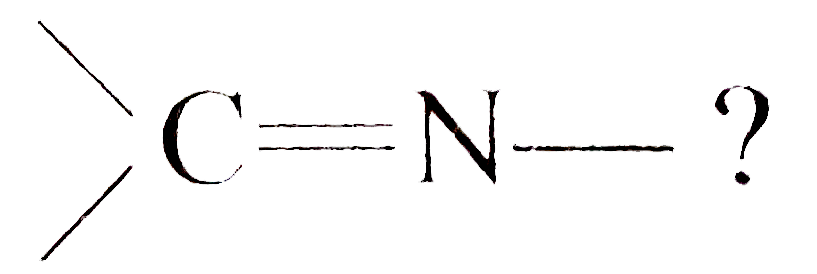 03:20View Solution
03:20View SolutionWhich of the following is an example of aldol condensation?
03:15View SolutionWhich of the following compounds will recact with ethanolic KCN?
04:07View SolutionWhich of the following compounds will give a yellow precipitate with iodine alkali?
03:45View SolutionBase catalysed aldol condensation occurs with
02:16View SolutionTwo aliphatic aldehydes P and Q react in th presence of aqueous `K_(2)CO_(3)` to give compound R, which upon treatment with HCN provides compound S. On acidification and heatingm,S gives the product shown below:

The compounds P and Q respectively are11:01View SolutionTwo aliphatic aldehydes P and Q react in th presence of aqueous `k_(2)CO_(3)` to give compound R, which upon treatment with HCN provides compound S. On acidification and heatingm,S gives the product shown below:
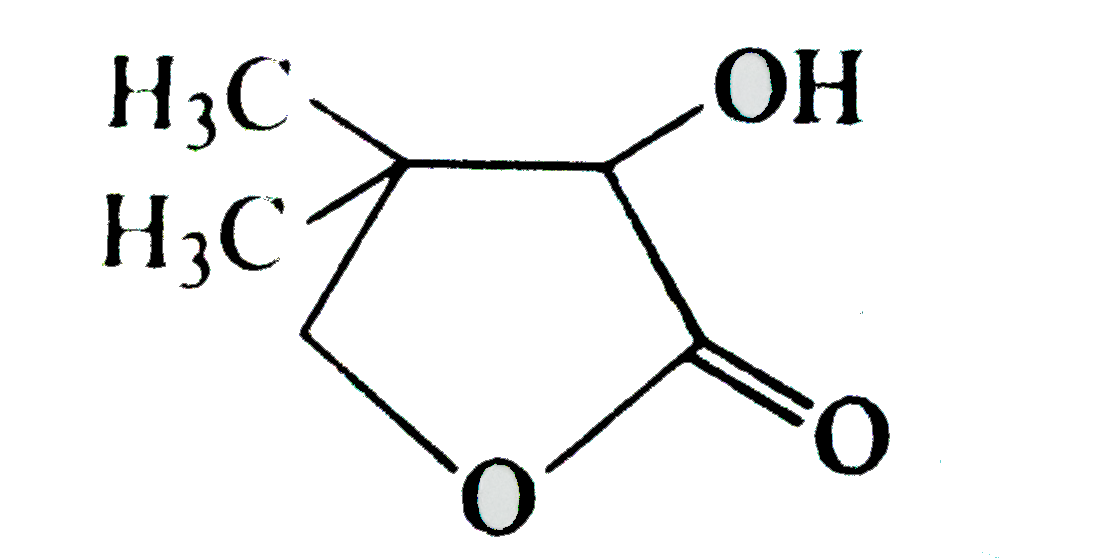
The compound R is11:01View SolutionTwo aliphatic aldehydes P and Q react in th presence of aqueous `k_(2)CO_(3)` to give compound R, which upon treatment with HCN provides compound S. On acidification and heatingm,S gives the product shown below:

The compound S is11:01View SolutionA carbon1 compoundj P, which gives positive idofrom test, undergoes reacrtion with MeMgBr followed by dehydration to give olefin Q Ozonolysis of Q leads to a dicarbony1 compound R, which undergoes intramolecular aldol reaaction to give predominantly S.
`Poverset(1.MeMgBr)underset({:(2.H^(+)","H_(2)o),(3.H_(2)SO_(4)//"heat"):})(to)Qoverset(O_(3)//Zn-H_(2)O)(to)Roverset(oh^(-))underset("heat")(to)S`
The structure of the carbony 1 compound P,is14:11View SolutionA carbon1 compoundj P, which gives positive idofrom test, undergoes reacrtion with MeMgBr followed by dehydration to give olefin Q Ozonolysis of Q leads to a dicarbony1 compound R, which undergoes intramolecular aldol reaaction to give predominantly S.
`Poverset(1.MeMgBr)underset({:(2.H^(+)","H_(2)o),(3.H_(2)SO_(4)//"heat"):})(to)Qoverset(O_(3)//Zn-H_(2)O)(to)Roverset(oh^(-))underset("heat")(to)S`
The structures of products Q and R respectivley, are14:11View SolutionA carbon1 compoundj P, which gives positive idofrom test, undergoes reacrtion with MeMgBr followed by dehydration to give olefin Q Ozonolysis of Q leads to a dicarbony1 compound R, which undergoes intramolecular aldol reaaction to give predominantly S.
`Poverset(1.MeMgBr)underset({:(2.H^(+)","H_(2)o),(3.H_(2)SO_(4)//"heat"):})(to)Qoverset(O_(3)//Zn-H_(2)O)(to)Roverset(oh^(-))underset("heat")(to)S`
The structure of the product S , is14:11View SolutionIn the following sequence, product I,J and L are formedK represents a reagent.

The structure of the product I is07:55View SolutionIn the following sequence, product I,J and L are formedK represents a reagent.
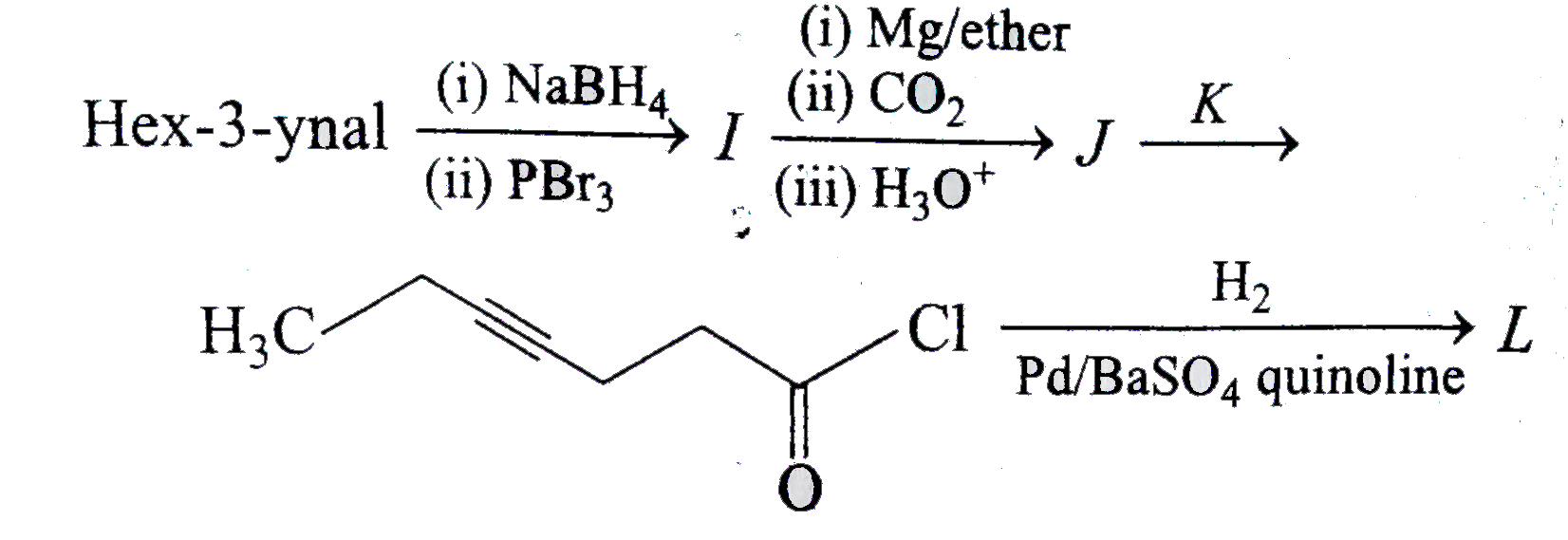
The structure of compound J and K, respectively are07:55View Solutionn the following sequence, product I,J and L are formedK represents a reagent.
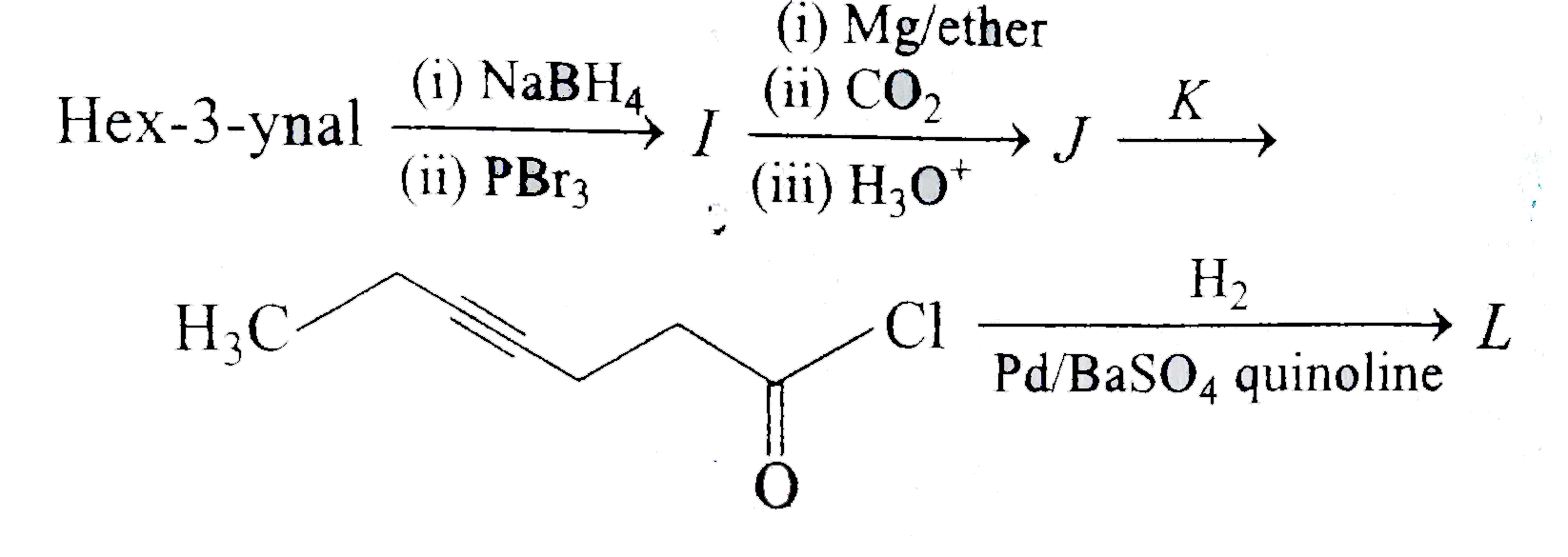
The structure of products L is07:55View SolutionMatch each of the compounds given in ColumnI with reaction (s) that they can undergo, given in Column II.
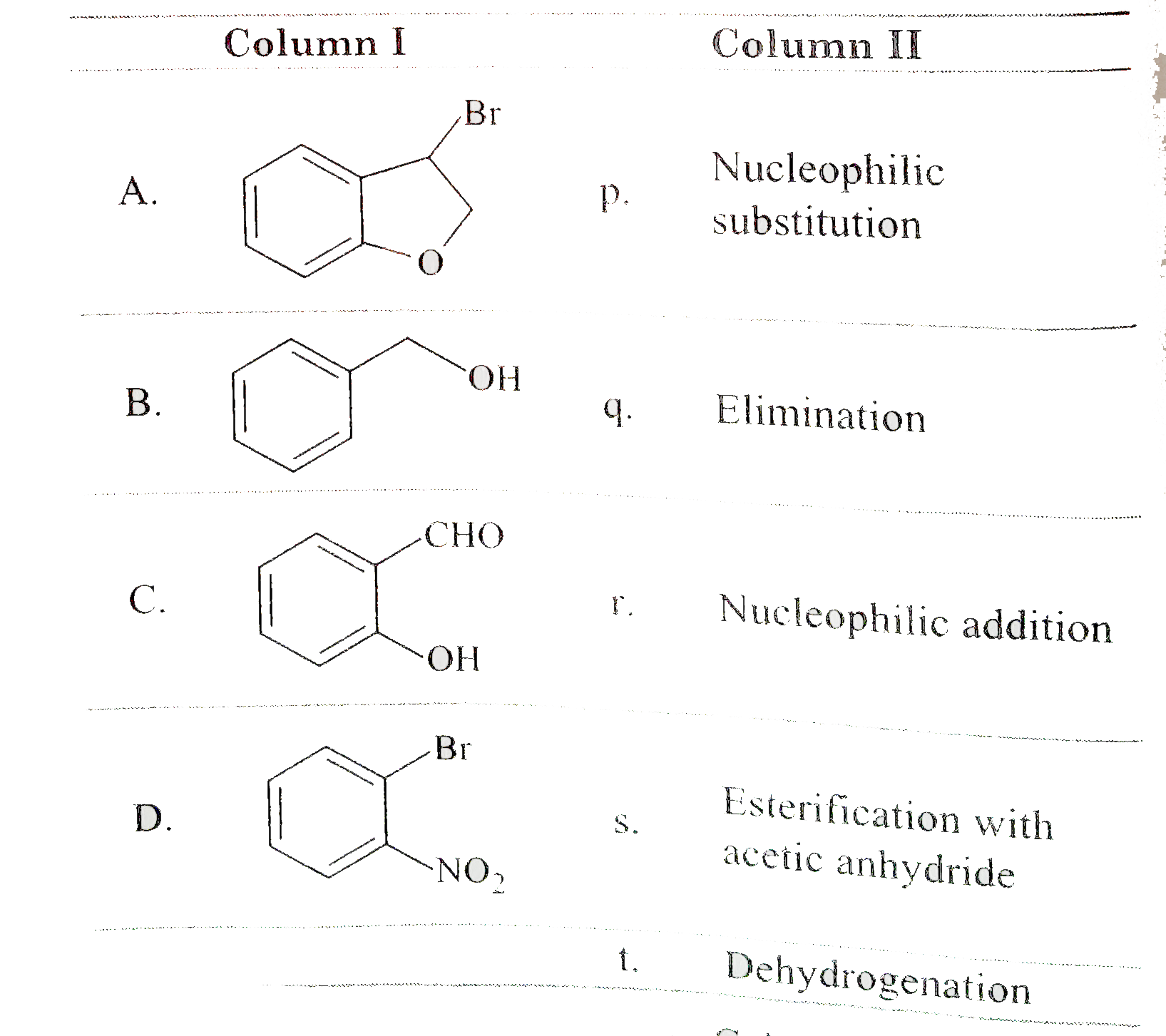 05:55View Solution
05:55View SolutionMatch the compouns`//ions` Column I with their properties`// reactions` in Column II.
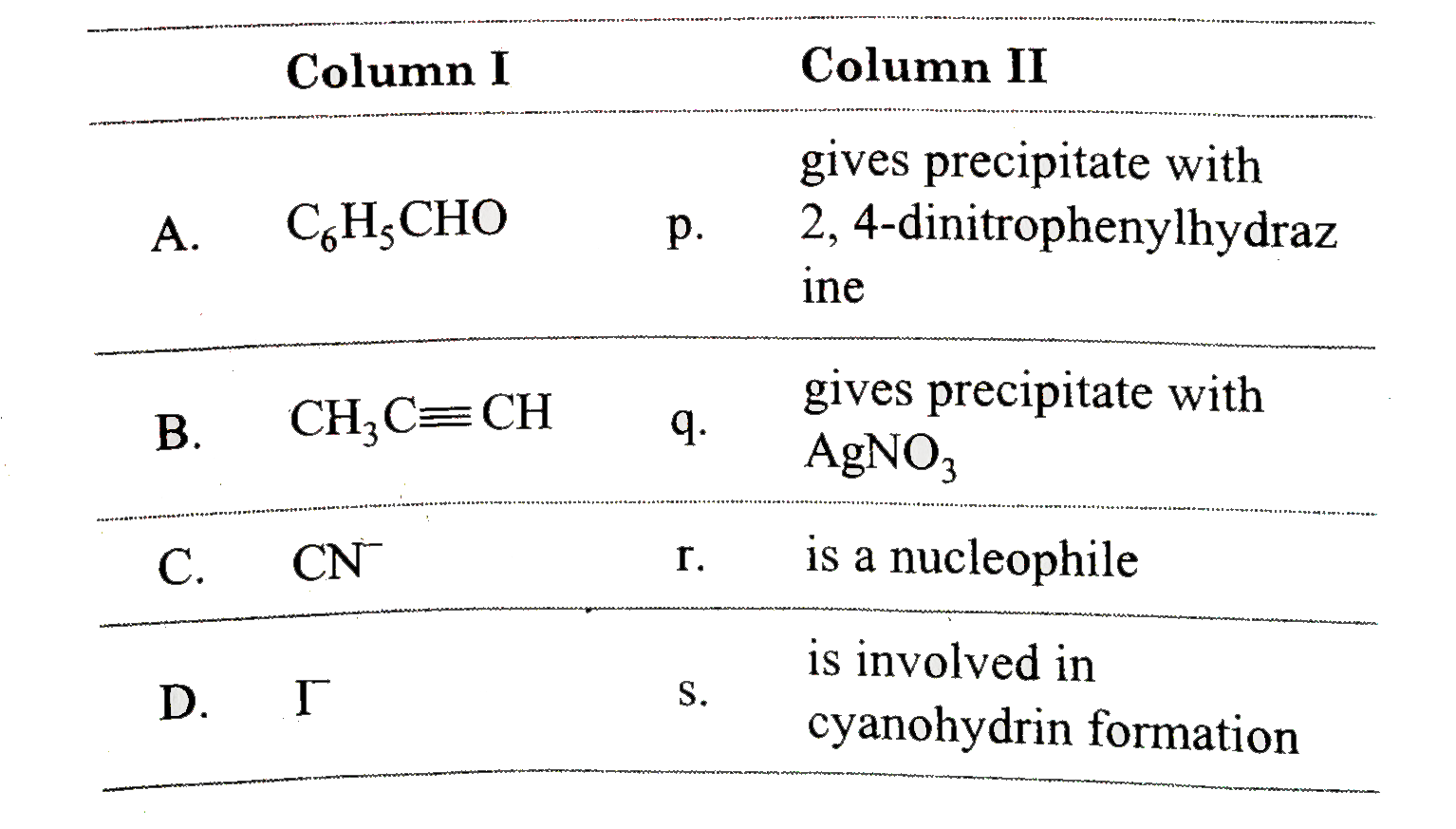 04:52View Solution
04:52View SolutionFehling's solution A consists of an aqueous solution of copper sulphate while Fehling's B consist of an alkaline solution....
02:04View SolutionThe reaction of methyl magnesium iodide with acetone followed by hydrolysis give secondery butanol.
01:42View SolutionBenzaldehyde undergoes aldol condensation in an alkaline medium.
01:51View SolutionIn the scheme given below. The total number of intramolecular aldol condensation products formed form Y is
 04:25View Solution
04:25View Solution`(C_(6)H_(12))overset(HCl)rarr underset((C_(6)H_(13)Cl))(B)+(C )`
`(B)overset(Alc.KOH)rarr(D)` [isomer of (A)]
`(D)overset("Ozonolysis")rarr(E )` (It gives negative test with Fehling's solution but responds to iodoform test)
`(A)overset("Ozonolysis)rarr(F)+(G)` (Both give positive Tollens test but do not give iodoform test)
`(F)+(G)overset("Conc.NaOH)rarr HCOONa` + A primary alcohol .
Identify A to G.09:44View SolutionA compound `C_(9)H_(7)O_(2)CI` exists predominanthly in enol from (A) and also in keto from (B) On oxideation with`KMnO_(4)` it gives m-chlorobenzoic acid as one of the products. Identify the compounds (A) and (B).
05:20View SolutionAn alkane (A) `C_(16)H_(16)` on ozonolysisi gives only one products (B) `C_(8)H_(8)O`. Compound (B) or reaction with `NaOH//I_(2)` yields sodium benzoate. Comopund (B) reacts with `KOH//NH_(2)NH_(2)` yielding a hydrogen (C) `C_(8) H(10)^(.)` Write the structures of compounds (B) and (C). Based on this infromation two their structures and identify the isomer which on catalytic hydrpgenation `(H_(2)//Pd-C)` gives a racemic mixture.
06:46View SolutionIdentify A, B and C, and give their structures.
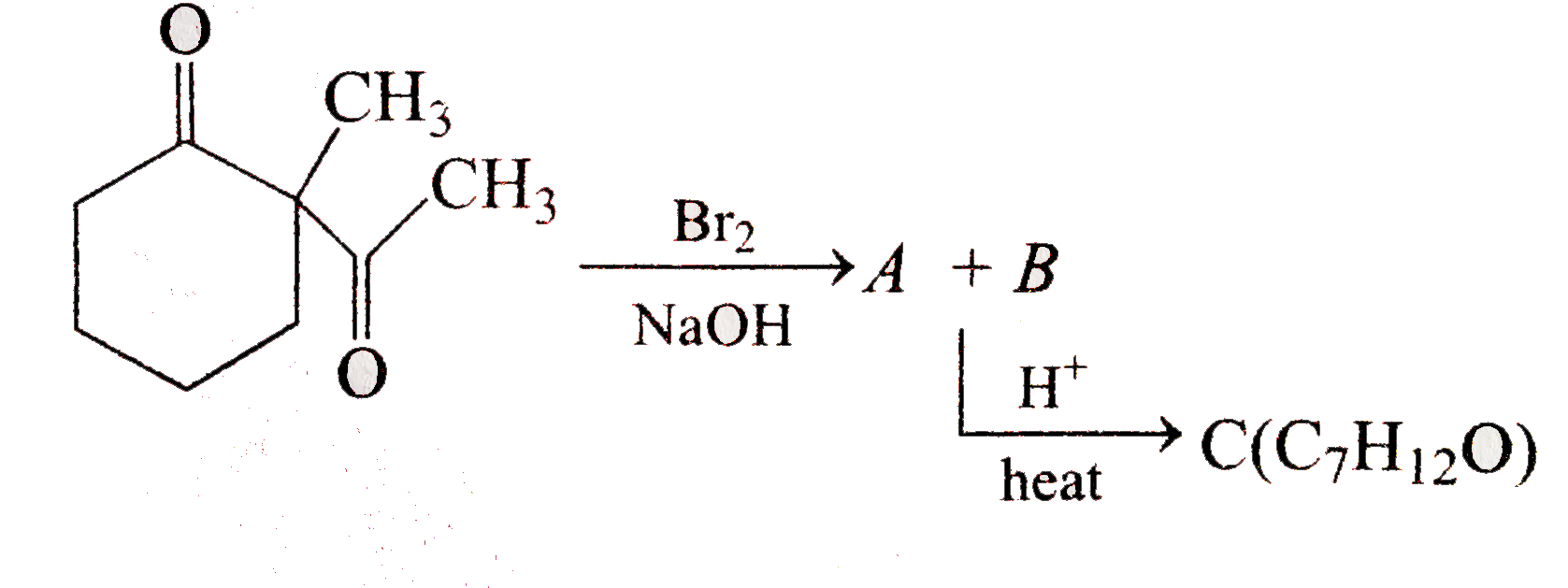 02:46View Solution
02:46View SolutionAn organic compound (A) `(C_(6)H_(10)O)` on reaction with `CH_(3)MgBr` followed by acid treatment gives compound (B). The compound (B) on ozonolysis gives compound (C ), which in the presence of a base gives 1-acetyl cyclopentene (D). The compound (B) on reaction with HBr gives compound (E ). Write the structures of (A), (B), (C ), (D), and (E ). Show how (D) is formed from (C ).
12:39View SolutionWhat would be the major product in the following reaction ?
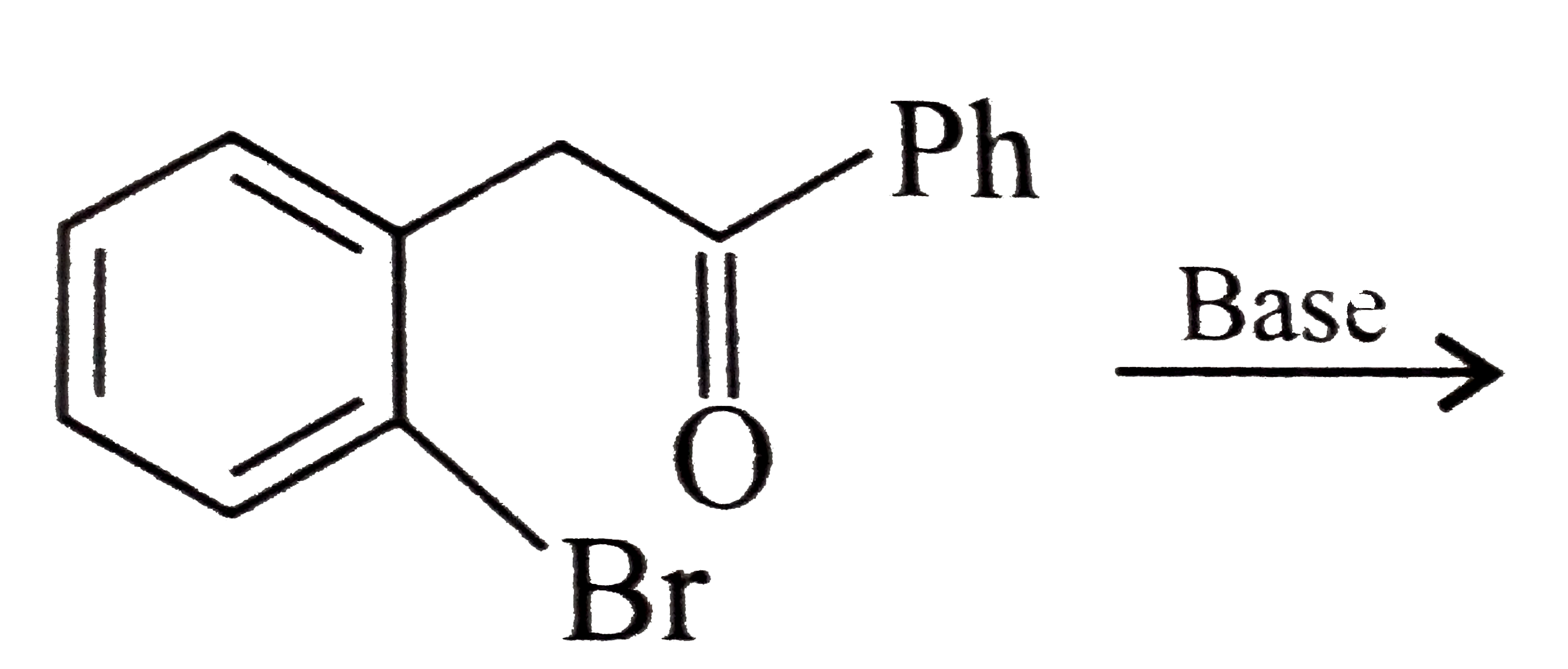 03:31View Solution
03:31View Solution(a) Compound A `(C_(8)H_(8)O)`on treatment with `NH_(2)`OH. HCI gives B and C. B and C rearrange to give D and E, respectively on treatement with acid. B, C, D and E are all isomers of moleculare formula `(C_(8)H_(9)N)` When D is boiled with alcohol KOH an oil F `(C_(6)H_(7)N)` separates out F, reacts rapidly with `CH_(3)` COOI to give back D. On the other hand. E on boiling with alkali followed by acidification gives a white solid G`(C_(7)H_(6)O_(2))`. Identify `A-G`
(b) Carry out the following transformation in not more than three steps. `1`-butyne "to" `2`-pentanone11:53View SolutionAn ester `A(C_4 H_8 O_2)`, on treatement with excess of methyl magnesium bormide followed by acidification, gives an alcohol `B` as the sole organic product. Alcohol `B` on oxidation with `NaOCl` followed by acidification gives acetice acid. Deduce the structures of `A` and `B`. Show the reactions involved.
05:39View SolutionWrite the intermediate steps for each of the following reactions
(i)`C_(6)H_(5)CH(OH)-=overset(H_(3)O^(+))rarrC_(6)H_(5)CH-=CHCHO`
(ii) 04:03View Solution
04:03View SolutionComplete the following reactions with appropriate structures of products //reagents.
 03:39View Solution
03:39View SolutionAn aldehyde (A) `(C_(11)H_(8)O)`, which does not undergo self aldol condensation, gives benzaldehyde and 2 mol of (B) on ozonolysis. Compound (B) on oxidation with silver ion gives oxalic acid. Identify the compounds (A) and (B).
04:59View SolutionAcetophenone on reaction with hudroxylamine lamine bydrochloride can produce two isomeric oximes. Write structures of the oxime.
02:37View SolutionComplete the following, gives the structures of the principal organic prodcuts.
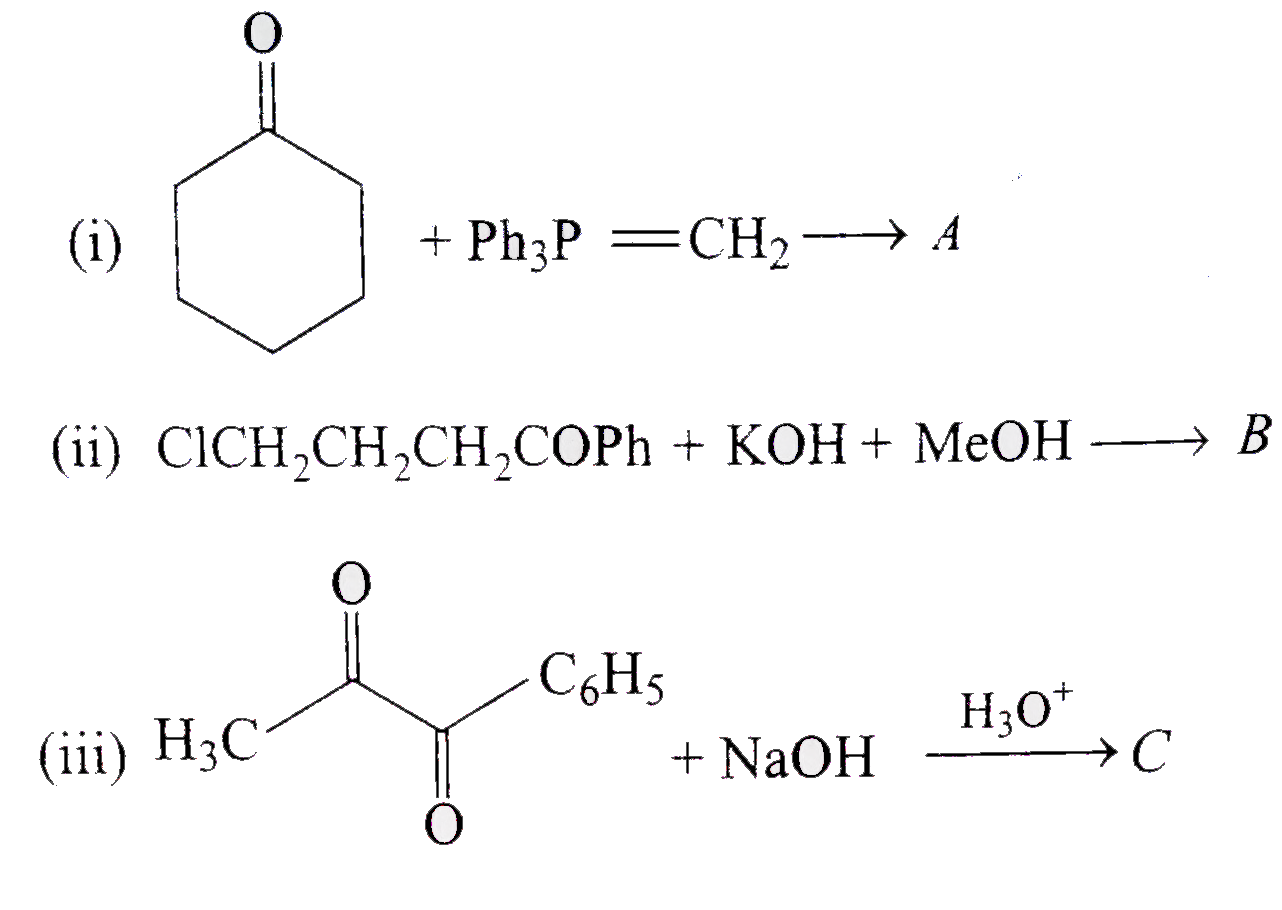 05:42View Solution
05:42View SolutionSuggest appropriate structurs for the missing compounds. ( the number of carbon atoms remains the same throughout the reaction)
 04:16View Solution
04:16View SolutionComplete the following reaction with apprpropriate structure:
 02:30View Solution
02:30View SolutionComplete the following reaction with appropriate structure.
`C_(6)H_(5)-CHO+CH_(3)-COOC_(2)H_(5)overset(NaOC_(2)H_(5)"in absolute")underset(C_(2)H_(5)OH "and heat")rarr` (A)04:19View SolutionWrite the structure of major organic product expected from the following reaction.
 05:12View Solution
05:12View SolutionArrange the following in the increasing order of expected enol content.
i. `CH_(3)COCH_(2)CHO`
ii. `CH_(3)COCH_(3)`
iii. `CH_(3)CHO`
iv. `CH_(3)COCH_(2)COCH_(3)`03:53View SolutionGive reason in one or two sentence:
Idoform is obtained by the reaction of aceton with hydpoiodite but not with iodide02:33View SolutionA ketone A, which undergoes halform reaction, gives compound B on reduction B on heating with sulphuric acid gives compounds C, which forms mono-ozonide D.D on hydrolysis in the presence of zinc dust gives only acetaldehyde. Identify A, B and C. Write down the reaction involved.
05:31View SolutionAnswere the following with suitable equation wherever necessary
(i) suggest a reagent to distinguish acetaldegyde from acetone.
(ii) what happens when excess chlorine is hpassed through boling toluene in the presence of sublight?02:44View SolutionComplete the following with appropriate structures.
 04:38View Solution
04:38View SolutionIn what manner the following transformation might be carried out (in not more than six steps) ? 'Benzaldehyde to cyanobenzene'
02:03View SolutionGive reasons in one or two sentances for the following: 'Hydrazones of aldehydes and ketones are not prepared in highly acidic medium'.
03:42View SolutionWrite down the main product of the following reaction. Propanal `overset(NaOH)underset(heat)rarr`
03:47View SolutionArrange the following in the order of their incresing reactivity towards HCN:
`CH_(3)CHO, CH_(3)COCH_(3), HCHO, C_(2)H_(5)COCH_(3)`05:02View SolutionArrange the following in the order of their incresing reactivity towards HCN:
`CH_(3)CHO, CH_(3)COCH_(3), HCHO, C_(2)H_(5)COCH_(3)`05:02View SolutionShow with balanced equation what happens when the following are mixed: 'Chloral is heated with aqueous hydroxide.'
02:35View SolutionAn alkane A on ozobolysis yields acetone and an aldeyde. The aldehyde is easily oxidised to an acid B. When B is treated with bromine in presence of yields a compound C which on hydrolysis gives a hydroxyle acid D. This acid can also be obatined from acetone by the reaction with hydrogen cyanide followed by hydrolysis. Identify the compounds A, B C and D.
08:55View SolutionOutline the reaction sequence for the conversion of methanal to ethanal (the number of steps should not be more than three).
02:09View SolutionWrite the structural formula of the main organic product formed when methanal reacts with ammonia.
01:52View Solution
`overset(CH_(3)CO_(3)H)rarr` Product of the reaction is01:20View SolutionWhich carbon-racbon bond could not be formed by an aldol condesation reaction?
 01:58View Solution
01:58View SolutionArrange the following in the increasing order of reactivity towards aldol condensation reaction
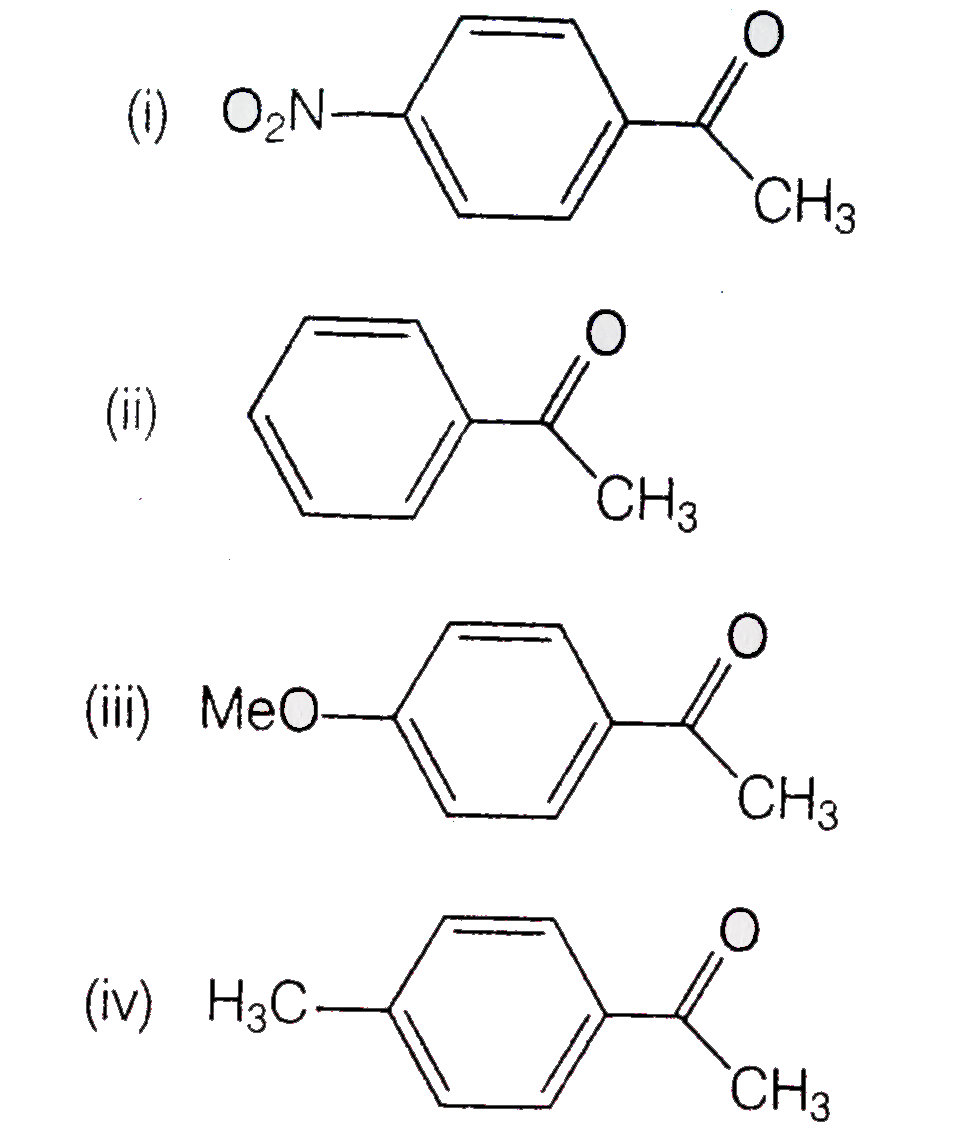 05:33View Solution
05:33View SolutionCompound `A(C_(7)H_(13)Br)` is a tertiary bromide. On treatement with sodium ethoxide in ethanol. A is treatement to a hydrocarbon B. Ozonolysis of B followed up by work up with `Zn-H_(2)O` gives 6-oxoheptanal as the only product The most likely structure of A is
04:33View Solutionyou have tow `C_(6)H_(10)O` ketones , I and II. Both are optically active , but is recemised by treatement with bass nanII is bot. Wolff- Kischner reduction of both ketones gives the same achiral gudrocarbon, formula `C_(6)H_(12)^(.)` What reasonable structures may be assigned to I and II?
07:02View SolutionTreatment of `(C_(5)H_(12)O)` with concemtrated sulphuric acid results in the formarion of threee alkenes inn differing yields Also. A forms a yellow precipitate on treatment with `NaOH//12`. A turn colour of acidified dichromate solution to blue green forming a new organic compound B which aslo foms yellows precipitate on treatement with `NaOH//12` The most likely name of A `is //are`
04:09View SolutionThe carbonyl compoun(s) that will undergo recemisaion on treatment with aqueous KOH `is //are`
05:13View SolutionWhich of he following reactions `has//have` equilbrium constant `(k_(C))` greater that one?
08:13View SolutionConsider the following reaction to answer the next three question:

The most likely structure of A is07:23View SolutionConsider the following reaction to answer the next three question:

if B is heated with `Zn(Hg)` in concentrated HCI solution the product formed is07:23View SolutionAssertion When pure `d-1(+)-2` methlylbutanal is treated with diute `H_(2)SO_(4)` it is racemised completely.
Reason It' s `alpha` carbon is chiral which undergo keto-enool tautomerism in the presence of acid catalyst.04:03View SolutionAssertion When benzaldgyde `(C_(6)H_(5)CHO)` is treated with concentrated NaOD solution in `D_(2)O` Cannizzaro reaction occur but no C-D(bonds with deuterium ) is formed .
Reason Cannizzaro reaction involes hydride transfer mechanism.03:41View SolutionMatch the carbonyls from left column with their characteristics from right column :
 08:50View Solution
08:50View Solutionif ethanedial (HOC-COH) is teated with excess of HCN (aq) followed by hydrolysis of product results in diacids. How many different diacids would be formed ?
03:14View SolutionIf `CH_(2)D-CHO` is treated with dilute alkaline solution how many different aldols (excluding steroisomers) are expected ?
02:52View Solution
JEE Main And Advanced questions and complete solutions for chapter ALDEHYDES AND KETONES of IIT-JEE PREVIOUS YEAR (CHEMISTRY) of Class 12
